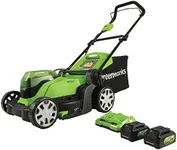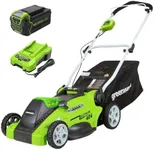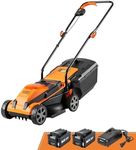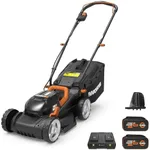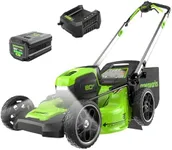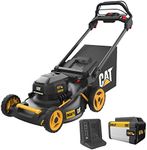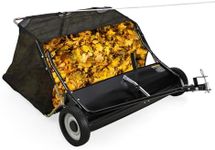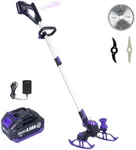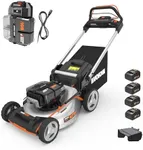Buying Guide for the Best Small Electric Lawn Mowers
Choosing the right small electric lawn mower can make maintaining your lawn a much easier and more enjoyable task. When selecting a lawn mower, it's important to consider various specifications to ensure it meets your needs. Here are some key specs to look at and how to navigate them to find the best fit for you.Cutting WidthThe cutting width refers to the width of the path the mower can cut in a single pass. This is important because it affects how quickly you can mow your lawn. Smaller cutting widths (14-16 inches) are ideal for small lawns and tight spaces, while larger cutting widths (18-20 inches) are better for medium-sized lawns. Choose a cutting width that matches the size of your lawn and the amount of maneuverability you need.
Power SourceElectric lawn mowers can be corded or cordless. Corded mowers are powered by plugging into an electrical outlet, providing continuous power but limiting your range to the length of the cord. Cordless mowers use rechargeable batteries, offering more mobility but requiring recharging. If you have a small lawn and easy access to power outlets, a corded mower might be suitable. For larger areas or more freedom of movement, a cordless mower is a better choice.
Battery LifeFor cordless electric mowers, battery life is crucial as it determines how long you can mow before needing to recharge. Battery life can range from 30 minutes to over an hour. If you have a small lawn, a shorter battery life may be sufficient. For larger lawns, look for mowers with longer battery life or the option to swap out batteries to extend mowing time.
Cutting Height AdjustmentCutting height adjustment allows you to change the height at which the mower cuts the grass. This is important for maintaining a healthy lawn, as different grass types and seasons may require different cutting heights. Mowers typically offer a range of height settings, from 1 to 4 inches. Choose a mower with easy-to-adjust settings that cover the range you need for your lawn.
Grass Management OptionsGrass management options include bagging, mulching, and side discharge. Bagging collects the clippings in a bag for easy disposal, mulching finely chops the clippings and returns them to the lawn as fertilizer, and side discharge ejects the clippings to the side. Consider how you prefer to handle grass clippings and choose a mower that offers the options you need.
Weight and ManeuverabilityThe weight of the mower affects how easy it is to push and maneuver, especially in tight spaces or on uneven terrain. Lighter mowers are easier to handle but may be less powerful. Heavier mowers can be more stable and powerful but harder to push. Consider your physical strength and the layout of your lawn when choosing the weight and maneuverability of your mower.
Noise LevelElectric mowers are generally quieter than gas mowers, but noise levels can still vary. If you live in a neighborhood with noise restrictions or prefer a quieter mowing experience, look for mowers with lower decibel ratings. This can make mowing more pleasant for you and your neighbors.
MaintenanceElectric mowers typically require less maintenance than gas mowers, but some maintenance is still necessary. Look for mowers with easy-to-clean decks, accessible blades for sharpening or replacement, and simple battery maintenance if cordless. Consider how much time and effort you are willing to invest in maintaining your mower.
